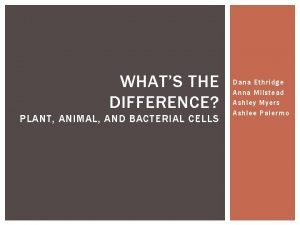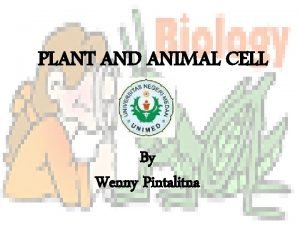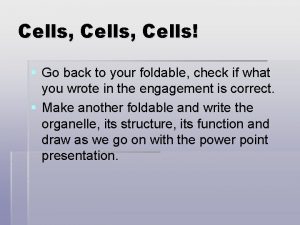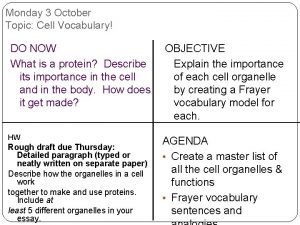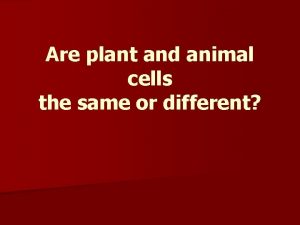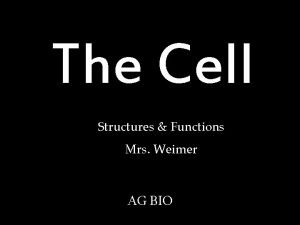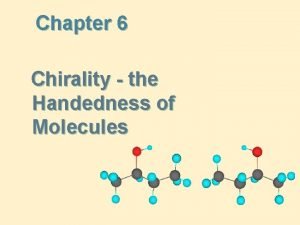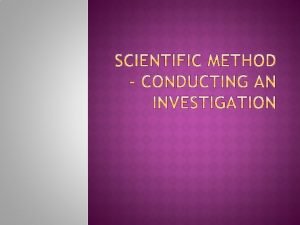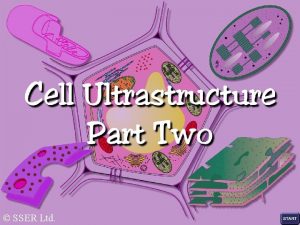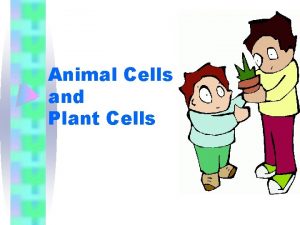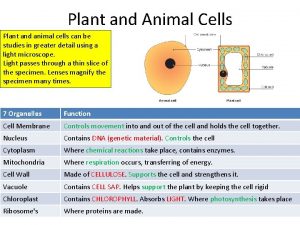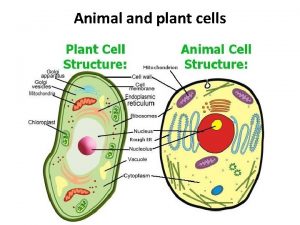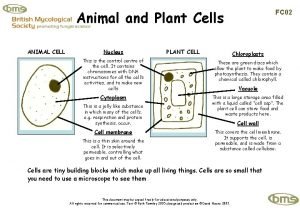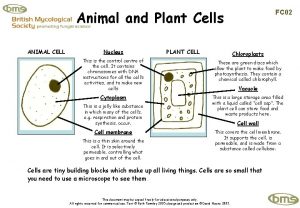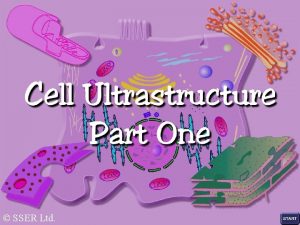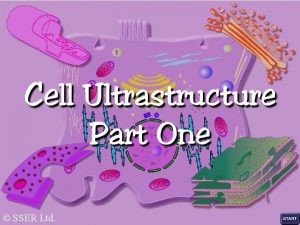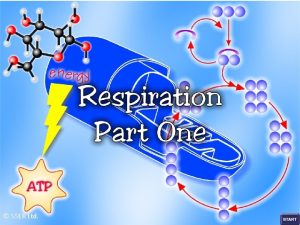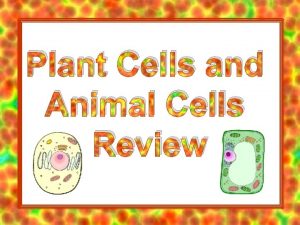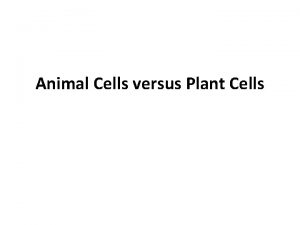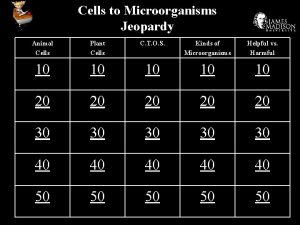SSER Ltd Plant cells like animal cells possess





















- Slides: 21

© SSER Ltd.

Plant cells, like animal cells, possess a plasma membrane within which is contained a complex fluid called the cytosol Plasma Membrane Unlike animal cells, the outermost boundary of the plant cell is the cell wall The cell wall is composed principally of the polysaccharide called cellulose The middle lamella is composed of ‘glue-like’ pectic substances Cytosol Cellulose Cell Wall The cell walls of adjacent plant cells are shown here Adjacent plant cells in a tissue are held together by a thin layer called the middle lamella

The cell wall is the outermost layer in plant cells composed mainly of cellulose. It consists of fibres embedded in a matrix. Chains of the complex carbohydrate, cellulose, group together to form the fibres. The matrix consists of pectins (e. g. calcium pectate) and hemicelluloses PROTOPLAST When a “young” plant cell is formed, it is surrounded by aprimarycell wall composed largely of cellulose. The cell wall is secreted by the protoplast it encloses This primary cell wall consists of cellulose fibres arranged atrandom within the matrix such that the primary wall is highly porous The random arrangement of fibres creates an elastic wall allowing for stretching as the young cell grows

As the plant cell grows, more cellulose fibres are secreted by the protoplast and laid down on the inside of the primary wall forming asecondary wall The cellulose fibres of the secondary wall are closely packed and laid down in an orderly way giving considerable rigidity to the cell wall ELECTRON MICROGRAPH Unlike the cell membrane, the cell wall is porous andfreely permeable to water, ions, sugars and other essential nutrients

In many cases, where adjacent plant cells are held together in a tissue, there is communication between the cells Adjacent cells are interconnected by fine strands of cytoplasm known as plasmodesmata These strands of cytoplasm pass through pores in the cell walls and the middle lamellae, thus forming minute but continuous cytoplasmic bridges between one cell and the next The cell wall provides mechanical support and protection for the plant cell


In common with animal cells, typical plant cells also possess a nucleus, rough and smooth endoplasmic reticulum, mitochondria, Golgi bodies and free ribosomes Free ribosomes Nucleus Smooth endoplasmic reticulum Rough endoplasmic reticulum Mitochondrion Golgi body These are the sub-cellular organelles typically found in EUKARYOTIC CELLS

Unlike animal cells, the majority of mature plant cells possess a characteristic large central vacuole Large central vacuole Nucleus Smooth endoplasmic reticulum Free ribosomes Rough endoplasmic reticulum Mitochondrion Golgi body

The vacuole is bounded by a membrane called the tonoplast Large central vacuole Nucleus Smooth endoplasmic reticulum The vacuole is a fluid filled sac containing cell sap. Cell sap is a concentrated solution of a variety of chemicals including sugars, mineral salts and enzymes Free ribosomes Tonoplast Rough endoplasmic reticulum Mitochondrion Golgi body The vacuole functions as a storage region for the cell and plays a major role in controlling cell shape and volume

Many plant cells possess large, oval-shaped organelles called chloroplasts Large central vacuole Nucleus Smooth endoplasmic reticulum Free ribosomes Tonoplast Rough endoplasmic reticulum Mitochondrion Golgi body Chloroplast The chloroplast is the organelle in which photosynthesis takes place producing sugars and other organic nutrients for the cell

The electron micrograph displayed below illustrates many of the plant cell characteristics discussed The cell wall, large central vacuole and chloroplasts are clearly visible Also visible is the clearly defined nucleus containing chromatin The vacuole in this mature plant cell from a leaf is large, and occupies about 80% of the cell volume Cell Wall Nucleus Chromatin Vacuole Chloroplasts

The chloroplast, the site of photosynthesis, is surrounded by anenvelope of two membranes and contains a jelly-like matrix called thestroma Envelope Stroma

Located within the stroma is an elaborate network of flattened membrane-bound discs calledthylakoids, in which light-capturing pigments, such as chlorophyll, are contained Envelope Stroma Thylakoids Circular DNA molecule Lipid droplet Ribosomes Many of the thylakoids are stacked to form grana A single granum The stroma also contains a circular DNA molecule, numerous ribosomes and lipid droplets

Many of the sugar molecules formed duringphotosynthesis are stored as starch and, starch grainscan be found growing close to the grana Envelope Stroma Thylakoids Circular DNA molecule Starch grain Lipid droplet Ribosomes Many of the thylakoids are stacked to form grana A single granum The stroma also contains a circular DNA molecule, numerous ribosomes and lipid droplets

The photograph shown below details chloroplast structure as viewed with a transmission electron microscope Chloroplast envelope Stroma containing numerous small ribosomes Lipid droplet Starch grain Courtesy of Electron Microscopy Unit The University of Lancaster A single granum Lamellae connecting different grana

Chlorophyll and other light absorbing pigments are located within the thylakoid membranes of the grana LIGHT ENERGY During photosynthesis, chlorophyll molecules absorb and areexcited by light The series of chemical reactions, leading to the synthesis of food, takes place in the fluid stroma These reactions are referred to as the LIGHT INDEPENDENT REACTIONS Excitation of chlorophyll These reactions are referred to as triggers a series of the LIGHT DEPENDENT REACTIONS reactions that take and involve the conversion of absorbed place on the grana light energy into chemical energy This chemical energy is used by the chloroplast to synthesis organic food

Typical plant and animal cells share a number of common features characteristic of eukaryotic cells Free ribosomes Nucleus Plasma membrane Smooth endoplasmic reticulum Cytosol Golgi apparatus Rough endoplasmic reticulum Mitochondrion Golgi apparatus Smooth endoplasmic reticulum Nucleus Free ribosomes

DIFFERENCES BETWEEN ANIMAL AND PLANT CELLS Large central vacuole for storage of cell sap and maintenance of cell shape and volume Cell wall for support and protection Centrioles; spindle formation during cell division in animal cells Chloroplast; site of photosynthesis Microvilli

RECORD THE DIFFERENCES BETWEEN THE TWO TYPES OF CELL

Plant and animal cells are eukaryotic cells Both types of cell possess characteristic organelles; • • • Nucleus Rough endoplasmic reticulum Smooth endoplasmic reticulum Mitochondria Golgi apparatus Microtubules Differences between mature plant and animal cells include: PLANT CELLS • Cellulose cell wall • Large vacuoles that store cell sap • Chloroplasts in photosynthetic cells ANIMAL CELLS • Microvilli • Centrioles

Acknowledgements For electron microscopy visit: http: //www. biols. susx. ac. uk/Home/Julian_Thorpe Copyright © 2003 SSER Ltd. and its licensors. All rights reserved. All graphics are for viewing purposes only.
 What is an organelle
What is an organelle Animal and plant cell similarities
Animal and plant cell similarities Animal rights vs animal welfare venn diagram
Animal rights vs animal welfare venn diagram Prokaryotes vs eukaryotes venn diagram
Prokaryotes vs eukaryotes venn diagram Rough endoplasmic reticulum function
Rough endoplasmic reticulum function Paragraph on animal cell
Paragraph on animal cell Whats the difference between plant and animal cells
Whats the difference between plant and animal cells Group of multicellular oxygen producers
Group of multicellular oxygen producers Cell theory foldable
Cell theory foldable Plant vs animal cells
Plant vs animal cells Whats the difference between plant and animal cells
Whats the difference between plant and animal cells Plant and animal cells
Plant and animal cells Differences between plant animal and bacterial cells
Differences between plant animal and bacterial cells Cpalms investigating plant and animal cells
Cpalms investigating plant and animal cells Endocytosis moves materials _____ a cell via ____
Endocytosis moves materials _____ a cell via ____ Flexible covering of an animal cell
Flexible covering of an animal cell R vs s stereochemistry
R vs s stereochemistry What important attitudes do successful scientists possess?
What important attitudes do successful scientists possess? Even quarter-wave symmetry
Even quarter-wave symmetry A news story possess singularity if it
A news story possess singularity if it Possess information
Possess information A news story possess singularity if it
A news story possess singularity if it

